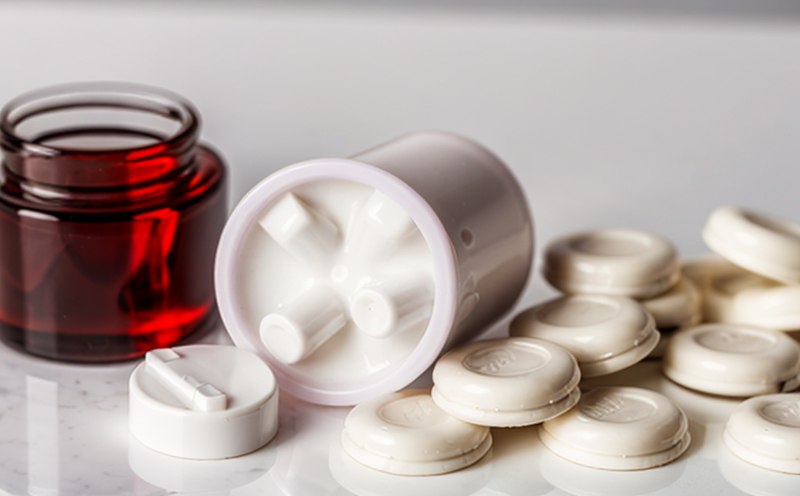USP Tablet Hygroscopicity Testing
The United States Pharmacopeia (USP) Tablet Hygroscopicity Testing is a critical quality assurance measure in pharmaceutical manufacturing. This test evaluates the moisture absorption capacity of tablets, which can affect product stability and shelf life. Hygroscopicity issues are particularly pertinent for oral solid dosage forms as they can lead to caking, crumbling, or changes in hardness, all of which may impact patient compliance.
The primary purpose of this testing is to ensure that the tablets meet USP standards for quality and safety, thereby safeguarding public health. Hygroscopicity testing helps manufacturers identify potential stability issues early in the production process, allowing for corrective actions before products reach the market. This not only enhances product quality but also ensures regulatory compliance with stringent pharmaceutical regulations.
Hygroscopicity testing typically involves exposing tablets to controlled humidity conditions over a specified period and then determining the weight gain of the tablets. The USP specifies that this test should be conducted at two levels: 40% relative humidity (RH) for stability testing and 75% RH for accelerated aging tests. These conditions simulate real-world storage environments, providing insights into how tablets might behave under various climatic conditions.
The equipment used in this testing is precise and standardized to ensure accurate results. A balance or moisture analyser capable of measuring small weight increments is essential. The process involves placing a known quantity of tablets on a pre-weighed container, sealing it, and then storing the container at the specified humidity levels for a set period. Afterward, the sealed containers are weighed again to determine any changes in weight due to absorbed moisture.
Understanding the results is crucial for quality assurance teams. A significant increase in tablet weight might indicate higher hygroscopicity, suggesting that the tablets may not be stable under certain conditions. Conversely, minimal change could imply better stability and shelf life. This information is vital for optimizing production processes and selecting appropriate packaging materials to protect products from moisture.
Hygroscopicity testing aligns with broader pharmaceutical quality assurance efforts by ensuring that all components of a product meet stringent standards. By focusing on this aspect during development, manufacturers can enhance their reputation for producing high-quality pharmaceuticals that are safe and effective. This testing contributes significantly to the overall goal of maintaining consistent product performance across different environmental conditions.
In summary, USP Tablet Hygroscopicity Testing is an indispensable tool in ensuring product quality and safety. It helps pharmaceutical companies adhere to regulatory standards while also improving their operational efficiency by identifying potential issues early on. Through rigorous testing at critical stages, manufacturers can build trust with consumers and regulators alike, ultimately contributing to the reliability of the entire industry.
Why Choose This Test
- Ensures compliance with USP standards for quality assurance.
- Identifies potential stability issues early in the production process.
- Provides insights into how tablets might behave under various climatic conditions.
- Aids in optimizing production processes and selecting appropriate packaging materials.
- Enhances product reliability and safety, thereby protecting public health.
- Safeguards against moisture-induced changes that could affect tablet quality.
- Supports the overall goal of maintaining consistent product performance across different environmental conditions.
Environmental and Sustainability Contributions
The practice of USP Tablet Hygroscopicity Testing also contributes positively to environmental sustainability. By identifying hygroscopicity issues early, manufacturers can take proactive steps to minimize waste by reworking or adjusting production processes before batches are finalized. This reduces the likelihood of producing substandard products that would otherwise need to be discarded.
Additionally, this testing supports sustainable packaging strategies by helping companies choose materials that provide optimal moisture protection without adding unnecessary layers or components. The insights gained from hygroscopicity testing can lead to more efficient use of resources in both production and packaging stages, thereby reducing the environmental footprint associated with pharmaceutical manufacturing.
The focus on quality also implies a commitment to resource efficiency throughout the supply chain. By ensuring that products are stable under various conditions, manufacturers can extend product shelf life, which reduces the need for frequent replacements or reorders. This not only saves resources but also minimizes waste and promotes more sustainable practices within the industry.
In conclusion, USP Tablet Hygroscopicity Testing plays a significant role in maintaining high standards of pharmaceutical quality while contributing to broader sustainability goals. By integrating this testing into their processes, manufacturers can contribute meaningfully to environmental conservation efforts without compromising on product quality or patient safety.
Competitive Advantage and Market Impact
The ability to conduct rigorous USP Tablet Hygroscopicity Testing provides a competitive edge in the pharmaceutical market. It allows companies to produce products that meet stringent standards, thereby building trust with consumers and regulatory bodies alike. This can lead to enhanced brand reputation and increased customer loyalty.
Moreover, by identifying potential stability issues early on, manufacturers can avoid costly recalls or product withdrawals. This proactive approach not only saves financial resources but also protects the company's reputation from negative publicity associated with quality failures. The ability to consistently produce high-quality products ensures that companies remain competitive in a highly regulated and increasingly scrutinized industry.
From an operational perspective, this testing can lead to more efficient production processes by highlighting areas for improvement. For instance, understanding hygroscopicity levels helps in optimizing production schedules and selecting appropriate packaging materials, which can reduce costs and enhance overall efficiency. These insights contribute significantly to the company's bottom line, providing a sustainable competitive advantage.
In terms of market impact, adherence to USP standards through rigorous testing demonstrates commitment to quality and safety. This can attract new customers and partnerships by signaling reliability and expertise in pharmaceutical manufacturing. In an era where consumer confidence is paramount, such practices help build long-term relationships with stakeholders, ultimately contributing to sustained growth and success in the market.





